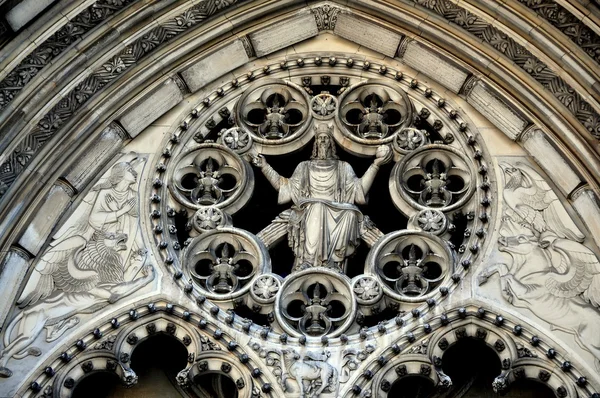
The relief carving of the symbols for the four evangelists surrounds the “Majestus” on the west front. The term tetramorph refers to a grouping of four. This is the work of the sculptor Theodore Barbarossa. It was likely modeled by the firm of Rochette & Parzini, and carved by their head carver, Mario Tommasi. The work was executed in the late 1960’s. The specific grouping of four here represents the four evangelists. Regardless of material – stained glass, mosaics, painting or stone – the symbolic representation of the four evangelists usually accompanies the image of the Majestus.
No doubt, Canon West was consulted on the iconography appropriate to the evangelists. From his book, Outward Signs – The Language of Christian Symbolism, we find the following:
“The four evangelists seem to have been the first of the saints to receive some visible token of recognition, becoming identified with the four ‘living creatures’ of Revelation. Although there was originally little agreement as to which creature represented which evangelist, there has been, since about the fifth century, a popular consensus…St. Jerome’s iconographic representation is now common to the whole church, East and West.”
– Canon Edward N. West
St. Jeromes representation:
- Matthew – the face of a man
- Mark – a lion
- Luke – an ox
- John – an eagle
The Pilgrims Frieze

The frieze immediately above the great bronze doors of the central portal is also by Barbarossa according to the National Sculpture review. We had previously attributed the design to Canon West and undoubtably there was a collaboration of sorts with the sculptor.
Theodore Barbarossa

Theodore “Ted” Cotillo Barbarossa (1906-1992) studied at Massachusetts College of Art and Yale University. He was a fellow of the National Sculpture Society, and a member of the National Academy of Design. Italian stone carving and plaster casting inspired him. Barbarossa worked in bronze, wood and stone. His work is in churches, museums and public buildings throughout the East Coast. As part of President Roosevelt’s WPA New Deal art initiative, Barbarossa created relief sculptures on post offices and other federal buildings depicting national ideals such as industry, education, and agriculture.
- National Sculpture Review, Winter 1971-72
- Legendary Locals of East Boston, Dr. Regina Marchi
- Tom Fedorek, Senior Guide, The Cathedral of St. John the Divine
- Previous post regarding the Pilgrims’ Frieze